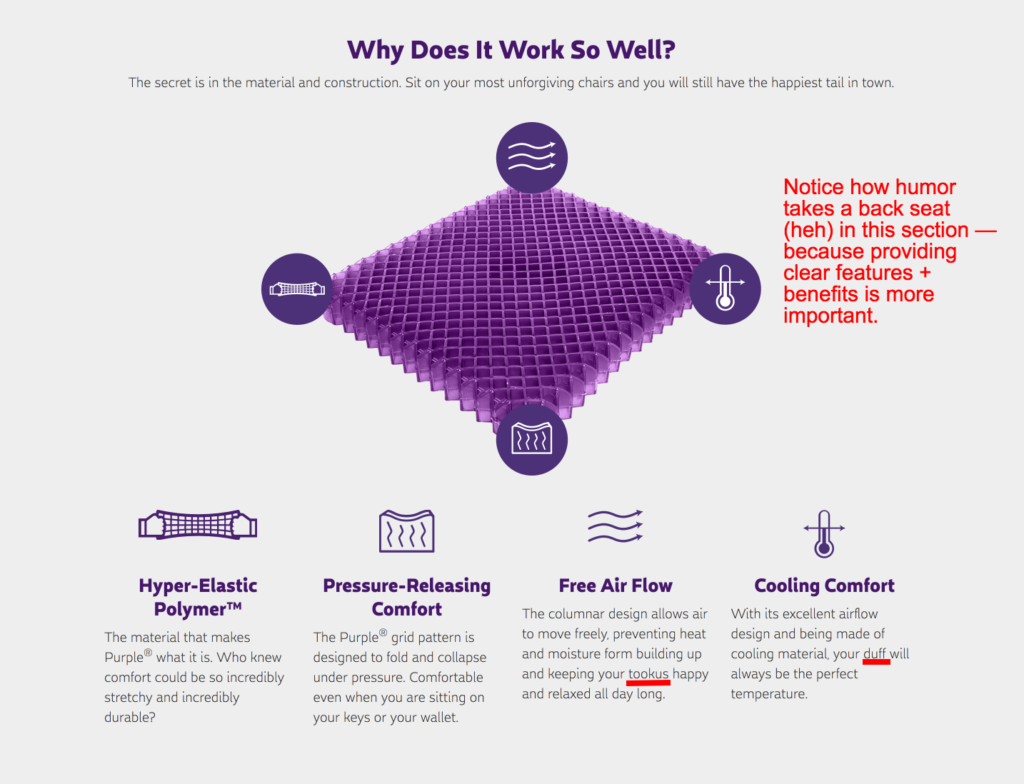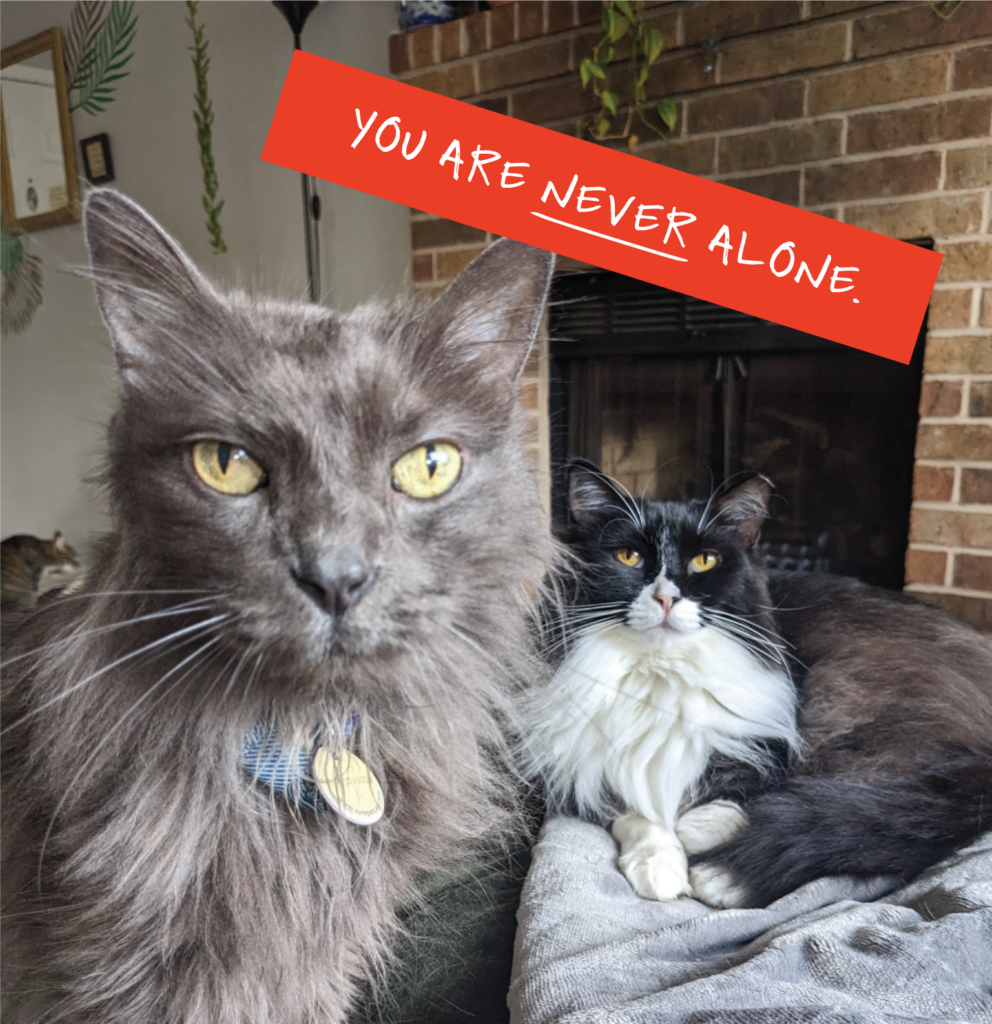If you’ve read a single sentence on PunchlineCopy.com, you already know I’m deeply (probably overly) invested in how humor, jokes, and personality can shape conversions and influence consumer decision-making.

But recently, I thought to myself,
“Hey, you know what? Maybe other folks don’t intrinsically love this idea as much as you. Maybe you need to SHOW them how and why humor works so well in marketing.”
So now I’m going around the Internet and finding hallmark examples of brands using humor strategically.
I’m screenshotting those emails and landing pages, annotating them, and painstakingly analyzing them right here on this homely little blog — so you can start to get where I’m coming from.
First up, we’ve got Purple.
Y’all probably know Purple. It’s the super cohesively branded mattress company that went viral with ads like this:
And their landing pages don’t disappoint, either. In keeping with the brand’s zany, carefree style, Purple’s landing pages use humor in combination with tried-and-testing copywriting best practices.
Here’s the Seat Cushion page, in all its glory:
Purple Seat Cushion Sales Page
Click to view a full-size, zoomable version of the annotated page in a new tab. Then scroll down for my thoughts on what Purple is doing and why it works.
What Purple is doing right on this page
Conversion-focused writers and UX specialists will notice the page design and layout first:
- It’s segmented into easy-to-parse sections…
- and features not one, but TWO videos showing the product in use.
- Bullet points and illustrations abound, making the page easy to take in. No walls of text here.
Plus, the copy asks and answers questions, showing readers that Purple truly understands its target market’s problems and has an effective solution on hand.
Check, check, check.
(As for why there are potentially distracting nav menu and footer links, the jury’s out. My guess? Purple’s analytics showed that without the opportunity to explore other pages of the site, visitors bounced — so they offered ’em the ability to click around and come back to this page when ready.)
Dig a little deeper into the copy, and you’ll notice three seriously strategic ways Purple is augmenting its already savvy presentation with humor.
How humor gives Purple the edge
1. Funny and varied word choice (plus wordplay!)
Did you even KNOW there were so many words for butts in the English language? I didn’t.
In nearly every headline and sentence of body copy, Purple says “butt” in a new and different way: derriere, tail, duff, wazoo…
They also gleefully take advantage of low-hanging joke opportunities like “pain in the butt,” and give their sentences a playful cadence by using alliteration, like “precious posteriors” and “squeeze and suffocate”.
Why does this work?
Using jokes and different words to describe the same part of the anatomy keeps the reader interested, entertained, and reading further — if for no other reason to see how many unique ways you can say “butt” (19 on this page, for the record).
2. Anthropomorphization
Wow, what a long, boring word for “attributing human form or personality to”.
Purple anthropormorphizes — what else? — the reader’s butt. We see this happen right away in the hero section headline and video, where a butt is endowed with the human emotion of sadness.
It even gets its very own “Sad Butt Diary” to catalog the many injustices that plague it.

A bit further down, Purple suggests that our butts have been “neglected” by uncomfortable chairs (effectively anthropomorphizing those chairs in the process, too).
Why does this work?
By mentally endowing a part of our own body with its own, distinct emotions, we can more effectively empathize with that part.
Only the most mindful among us has the elastic mental perspective it takes to examine our own thoughts, feelings, and sensations from afar — but given a little mental distance from our butts, we just might start to see them more objectively.
And thinking of your butt as a separate entity also makes it easier to rationalize giving dat booty a nice present. After all, you can deal with being uncomfortable. It’s just you (and you’ve probably dealt with worse).
But when it’s your butt that’s bummed? And that butt feels like a “precious” friend whom you’ve been overlooking?
Well, you’d be a monster to ignore your friend’s complaints, wouldn’t you?
3. Strategic deployment of humor
I saved the best for last.
One of the most common questions I hear (after “Is that your natural hair color?”) is, “But where and when should I use humor in my marketing?”
My answer is the same as it is to many other copywriting questions: It depends.
It depends on your branding, your prospect’s stage of awareness of your product, your risk tolerance for pushing the humor envelope, and a whole host of other things.
BUT(T).
In general, you want to cut “cleverness” in favor of clarity. That’s a pretty hard-and-fast copywriting rule.
So it follows that you’d want to eschew humor in the parts of your marketing that are closest to the sale.
Look at where Purple is laying off the jokes and just presenting the facts, albeit in the same lively tone:

Why does this work?
By avoiding potentially distracting readers with humor — or accidentally over-easing readers’ anxiety, some of which is necessary to motivate a sale — Purple keeps the focus on its… bottom line.
Got something to add? Leave a comment!








5 Comments
-

-

-

-

Pingback Links That Mattered In February 2020 – JuhoTunkelo.com